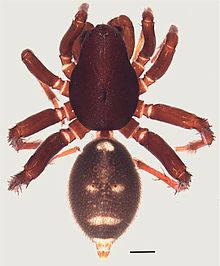en
names in breadcrumbs


The spider family Zodariidae includes 1074 described species (Platnick 2014). These are burrowing spiders with long anterior spinnerets (Jocqué 1991). Although little is known about most zodariids, members of the genus Zodarion apparently feed only on ants; a number of other genera in the family are apparently also ant (or termite) specialists. Only 5 species have been described from North America north of Mexico (all rarely encountered), including four species of Lutica (endemic to the southern coast and offshore islands of California south to Baja California) and a single Zodarion species, the Eurasian Z. rubidum. In North America, Z. rubidum was first recorded in Pennsylvania (as Z. fulvonigrum) by Vogel (1968), but was recognized as Z. rubidum by Bosmans (1994) and subsequently recorded from Colorado by Cushing and Santangelo (2002) and from Québec by Paquin and Dupérré (2006); according to Bradley (2013), it has also been found in Ohio and British Columbia. In central California, there is apparently a Zodarion species found in serpentine grassland habitats that can be seen running along the ground and rocks even during the hottest part of the day, suggesting this is a species distinct from the nocturnal Z. rubidum. According to Roth (1994), there is also an undescribed fifth species of Lutica known from the coast of California.(Ubick and Craig 2005)
The phylogeny and historical biogeography of Lutica were investigated by Ramírez and Beckwitt (1995) using allozyme electrophoresis. Lutica spiders are found along coastal sand dunes, where they live in underground silken burrows and capture prey by biting through the burrow walls (Ramírez 1995). Zodarion rubidum are found on and beneath rocks, where they build retreats covered with sand grains and feed on ants (Jocqué 1991). An ant is typically attacked with a bite on the leg, to which the ant may respond by grooming or even removing the leg. Eventually (sometimes after additional bites), paralysis sets in and the spider removes the paralyzed ant to begin feeding on it. (Cushing and Santangelo 2002).
(Ubick and Craig 2005)


Ant spiders are members of the family Zodariidae. They are small to medium-sized eight-eyed spiders found in all tropical and subtropical regions of South America, Africa, Madagascar, Australia-New Guinea, New Zealand, Arabia and the Indian subcontinent.[3] Most species are daytime hunters and live together with ants, mimicking their behavior and sometimes even their chemical traits.[3] Although little is known about most zodariids, members of the genus Zodarion apparently feed only on ants; a number of other genera in the family are apparently also ant (or termite) specialists.[4]
As of December 2022, the World Spider Catalog accepted the following genera:[1]
 Male Palindroma morogorom
Male Palindroma morogorom  Female Mallinella shimojanai
Female Mallinella shimojanai Ant spiders are members of the family Zodariidae. They are small to medium-sized eight-eyed spiders found in all tropical and subtropical regions of South America, Africa, Madagascar, Australia-New Guinea, New Zealand, Arabia and the Indian subcontinent. Most species are daytime hunters and live together with ants, mimicking their behavior and sometimes even their chemical traits. Although little is known about most zodariids, members of the genus Zodarion apparently feed only on ants; a number of other genera in the family are apparently also ant (or termite) specialists.